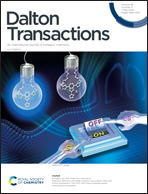Coordination chemistry of [Y(pypa)]− and comparison immuno-PET imaging of [44Sc]Sc- and [86Y]Y-pypa-phenyl-TRC105†
Abstract
Both scandium-44 and yttrium-86 are popular PET isotopes with appropriate half-lives for immuno-positron emission tomography (immuno-PET) imaging. Herein, a new bifunctional H4pypa ligand, H4pypa-phenyl-NCS, is synthesized, conjugated to a monoclonal antibody, TRC105, and labeled with both radionuclides to investigate the long-term in vivo stability of each complex. While the 44Sc-labeled radiotracer exhibited promising pharmacokinetics and stability in 4T1-xenograft mice (n = 3) even upon prolonged interactions with blood serum proteins, the progressive bone uptake of the 86Y-counterpart indicated in vivo demetallation, obviating H4pypa as a suitable chelator for Y3+ ion in vivo. The solution chemistry of [natY(pypa)]− was studied in detail and the complex found to be thermodynamically stable in solution with a pM value 22.0, ≥3 units higher than those of the analogous DOTA- and CHX-A′′-DTPA-complexes; the 86Y-result in vivo was therefore most unexpected. To explore further this in vivo lability, Density Functional Theory (DFT) calculation was performed to predict the geometry of [Y(pypa)]− and the results were compared with those for the analogous Sc- and Lu-complexes; all three adopted the same coordination geometry (i.e. distorted capped square antiprism), but the metal-ligand bonds were much longer in [Y(pypa)]− than in [Lu(pypa)]− and [Sc(pypa)]−, which could indicate that the size of the binding cavity is too small for the Y3+ ion, but suitable for both the Lu3+ and Sc3+ ions. Considered along with results from [86Y][Y(pypa-phenyl-TRC105)], it is noted that when matching chelators with radionuclides, chemical data such as the thermodynamic stability and in vitro inertness, albeit useful and necessary, do not always translate to in vivo inertness, especially with the prolonged blood circulation of the radiotracer bound to a monoclonal antibody. Although H4pypa is a nonadentate chelator, which theoretically matches the coordination number of the Y3+ ion, we show herein that its binding cavity, in fact, favors smaller metal ions such as Sc3+ and Lu3+ and further exploitation of the Sc-pypa combination is desired.
![Graphical abstract: Coordination chemistry of [Y(pypa)]− and comparison immuno-PET imaging of [44Sc]Sc- and [86Y]Y-pypa-phenyl-TRC105](/en/Image/Get?imageInfo.ImageType=GA&imageInfo.ImageIdentifier.ManuscriptID=D0DT00437E&imageInfo.ImageIdentifier.Year=2020)


 Please wait while we load your content...
Please wait while we load your content...